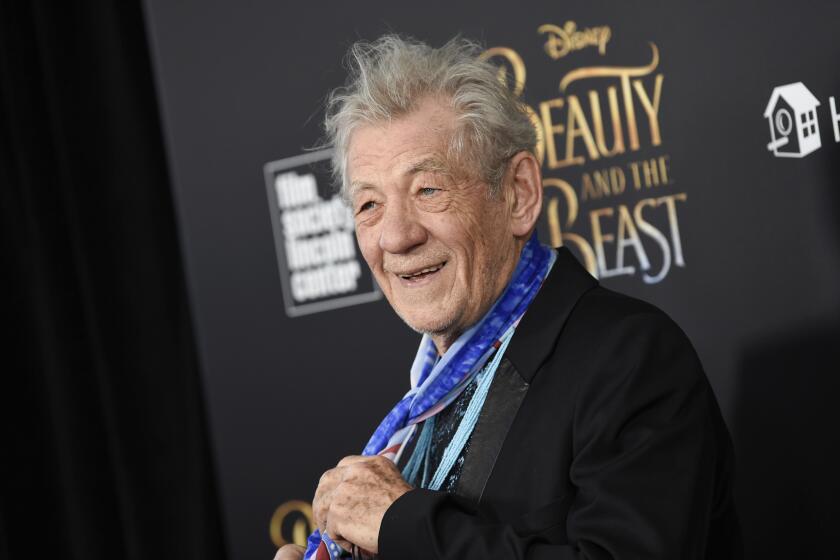The Difficult ‘Pierrot’ Easily Draws a Crowd
Musicians have always been fired by the moon. The history of song would be greatly diminished without the romance roused by moonbeams. Modern music would be equally diminished without Schoenberg’s radical “Pierrot Lunaire,” which, after nearly 90 years, still startles.
Certainly it would seem that we have long since left behind this particular Pierrot, a clown out of commedia dell’arte, morbidly intoxicated on “the wine that through the eyes is drunk,” in the words that begin the piece. These 21 songs--declaimed by a woman in a style of spoken singing that Schoenberg invented, and accompanied by five instrumentalists playing complicated contrapuntal music--might seem tame next to, say, the grisly gore in shock cinema. But Pierrot is insidious, inexplicable, haunting, as he playfully cavorts in a wicked environment. Something here is very wrong, ghoulish and maybe dangerous, but it is not the simple evil of violent crime.
“Pierrot Lunaire” is a very difficult piece to perform and to comprehend. Still, it commands a following; indeed, “Pierrot” is in the air. Monday night, the Los Angeles Philharmonic made it the highlight of its sold-out Schoenberg concert by the orchestra’s New Music Group at the opening of the Green Umbrella series at Zipper Hall in the Colburn School. Meanwhile, over the weekend, “Pierrot” was a hot ticket in New York. It was performed by the Chamber Music Society of Lincoln Center with Peter Serkin as part of a two-part Schoenberg celebration and also by the Metropolitan Opera Chamber Ensemble at Carnegie Hall in a performance led by James Levine, with Dawn Upshaw as soloist.
There are several reasons “Pierrot” remains not just fresh but also continually surprising. One is that its instrumental complexities are such that one always hears something new and different in it, and the balances are so tricky that the perspective changes with every performance. Another is that the vocal part is personal. It can be almost sung, but the pitches are expected only to show the shape of vocal inflection not necessarily to be hit precisely.
What Schoenberg wanted was heightened expression, and German actress Barbara Sukowa had no hesitation in giving him that and probably more. Sukowa is, at best, a pop chanteuse who told the audience in a pre-concert discussion that it would never in the world have occurred to her to perform modern music had she not been approached by Dutch conductor Reinbert de Leeuw after he saw her in “Lola,” the film by Rainer Werner Fassbinder.
She has a raspy voice (well-suited for Kurt Weill) and an extravagant manner. She can be a fine actress; she is stirring in Margarethe von Trotta’s “Rosa Luxemburg.” But here she seemed to let herself go, offering a vivid study in madness, releasing one internal demon after another. She was more than free with Schoenberg’s pitch suggestions and often ignored them altogether. Worked up to a climax, she would simply shriek.
There is allure in this approach. Sukowa commands the stage, and a sophisticated musical audience responded with a great ovation. But there is also much lost in the process, both in the words, which were not carefully declaimed to Schoenberg’s exciting rhythms, and in her inability to respond closely to the quintet, which was conducted with understated finesse by Esa-Pekka Salonen. There was characterful playing, both theatrical and musical: Catherine Ransom’s flute and piccolo were dazzling; David Howard’s clarinets provided exciting bursts of color; Barry Gold’s cello brought needed warmth. The other players were Stacy Wetzel, violin and viola, and Joanne Pearce Martin, piano.
The program was the only one of the Philharmonic’s “Schoenberg Prism” devoted entirely to the composer, and it selected widely, including the early Chamber Symphony No. 1 and the late “Ode to Napoleon Buonaparte.” Salonen has conducted the Chamber Symphony often, and always with great clarity and flair. Many in this ensemble, however, were not among the first desk players. There were many luminous and exciting moments, but overall there was a lack of confidence.
The “Ode to Napoleon,” for string quartet, piano and reciter, is a setting of Byron’s poem against tyranny in Schoenberg’s speech-song style. Christpheren Nomura, a baritone who sings frequently with the New York City Opera, was impressive, with a booming voice and exacting sense of rhythm. In this instance, it was the instrumentalists who were less alert musically. Yasuo Shinozaki, who recently became the Philharmonic’s assistant conductor, led the performance.
More to Read
The biggest entertainment stories
Get our big stories about Hollywood, film, television, music, arts, culture and more right in your inbox as soon as they publish.
You may occasionally receive promotional content from the Los Angeles Times.







